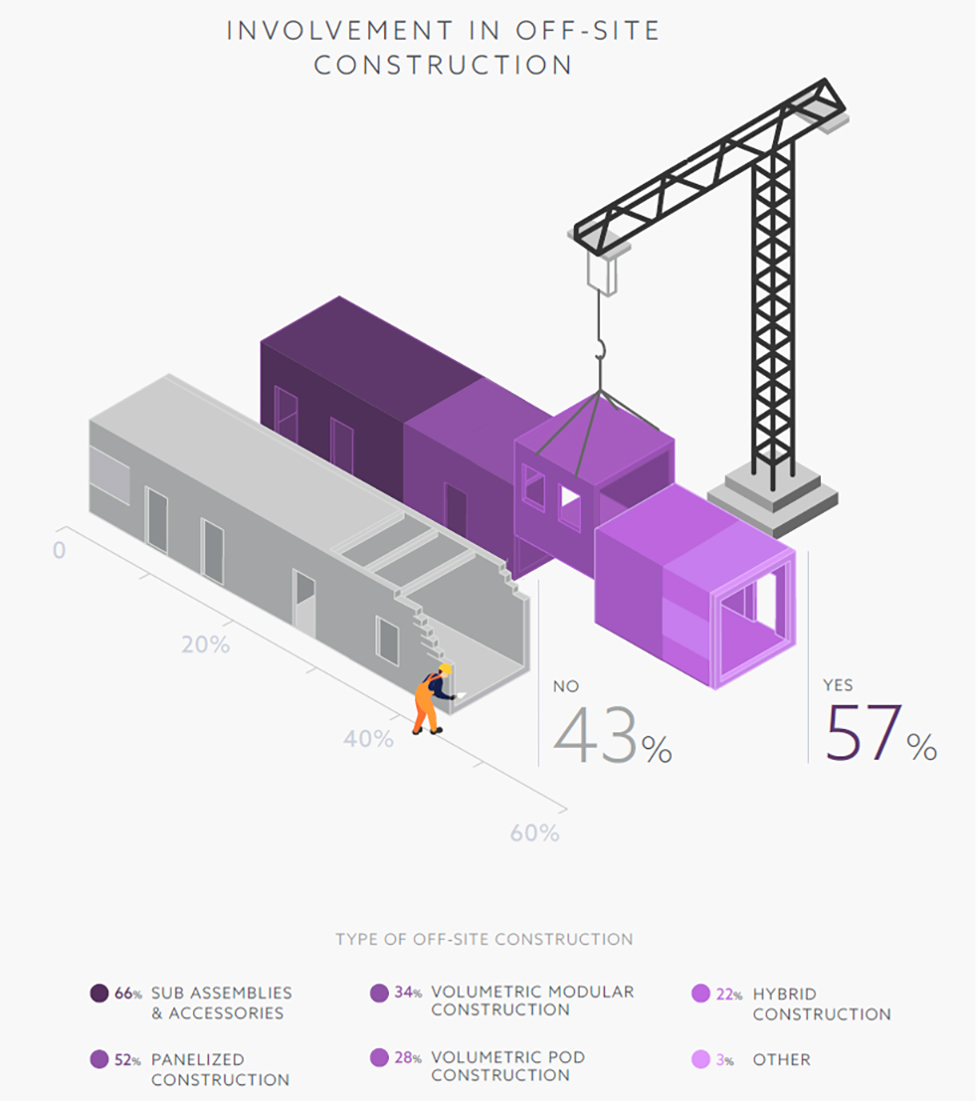David Bain is research manager at NBS and Allan Wilen is economics director at Glenigan
Recent years have seen a number of reports and initiatives advocating greater use of modern methods of construction (MMC) – but has this level of support resulted in more projects using this approach?
According to Glenigan, there has been a gradual rise in the proportion of projects utilising MMC approaches. Around 9 per cent of new-build projects starting in 2017 employed MMC in some way. This rose to a high of 17 per cent in late 2022, with the latest figures at 16 per cent in 2023. Growth has fluctuated, but the overall trend is clearly upward.
Looking at Glenigan data, we can see that the take-up of offsite construction, as a subset of MMC, has been especially strong for new-build projects. It was utilised in 7 per cent of new-build projects started during the first nine months of 2023. By value, the proportion is higher (11 per cent), reflecting the prevalence of offsite construction or manufacture on higher-value projects.
While there is a lot of focus on how offsite can help solve the housing crisis, offsite construction or manufacturing has made the greatest inroads into other sectors. The proportion of new starts that included some offsite elements was highest in industrial (29 per cent), education (15 per cent), and hotel and leisure (11 per cent). The numbers are higher for new-builds; for example, more than 22 per cent of new-build education projects included an element of offsite. The Department for Education has established an offsite framework for school buildings.
Use of different types of offsite construction
The 2023 NBS Digital Construction Survey, published last November, found that 57 per cent of respondents had been part of a project that involved an element of offsite construction. This is an increase from 50 per cent in the previous 2021 survey, reflecting the increase in adoption of offsite evident in the Glenigan data. For consultants (such as architects and engineers), the figure was 58 per cent, and it was 63 per cent for contractors.

(Source: NBS)
Drilling down, the most common type of offsite construction was for sub-assemblies and accessories. This is a broad category, potentially comprising any set of components made in a factory and brought to site. It can include many components, such as fairly large elements like roof trusses, staircases, doorsets, precast concrete beams and prefabricated dormers. It can also include small components that may not be readily associated with offsite construction, such as door locks and handles. The use of sub-assemblies may be taking place alongside traditional construction methods.
The other forms of offsite construction involve more substantial parts of a building or asset. These range from flat-packed panels, such as structural insulated panels like insulation between timber panels. Panellised systems can be timber-framed or steel-framed. These systems can include services like electrical sockets and water feed pipes. Over half of the survey respondents (52 per cent) told NBS that they were involved in projects using panellised systems.
Just under a third (28 per cent) of professionals responding to the NBS survey were involved in projects using volumetric pod construction. They are partly assembled into three-dimensional rooms before leaving the factory, and are sometimes combined with panels (such as bathrooms used in hotels, for instance, or kitchens). This kind of hybrid approach was cited by 22 per cent of survey respondents.
Finally, modular construction (where large sections of the building are constructed into entire building modules) was utilised on projects by 34 per cent of survey respondents. These include projects like blocks of flats or schools that consist of identical substructures manufactured as modules. There are several examples of residential buildings in the UK, such as Greenford Quay in London.
If we exclude survey respondents that were only involved in projects using sub-assemblies and accessories, the proportion involved in projects using panellised or modular construction was 45 per cent.
Future adoption
There have been some setbacks for MMC, with the closure of some modular factories and housebuilders going into administration. One of the reasons for these closures is the lack of stability in the construction market, with fluctuations in demand. Regulations and standards relating to MMC and offsite construction are also limited – although there has been activity to address this, with BSI carrying out a review of related standards. Some of these challenges were highlighted in the recent inquiry by the House of Lords Built Environment Committee, which pointed to issues with the government’s approach to MMC. However, the inquiry recognised the MMC successes evident elsewhere – in housebuilding outside the UK, and in non-residential UK buildings.
Despite these challenges, the signs are that MMC and offsite construction will continue to see further growth. According to Glenigan, nearly 9 per cent of new-build projects securing detailed planning approval during the first nine months of 2023 involved an offsite element. Strikingly, a number of leading housebuilders have invested in their own offsite facilities; such vertical integration may provide a base level of demand for the manufacturing operations, reducing exposure to volatile market conditions.
In addition, economic, regulatory and environmental performance issues are set to encourage further growth in the use of offsite construction or manufacture over the medium term. The shortages of skilled labour are likely to intensify as the construction industry emerges from the current market downturn. The Building Safety Act is also set to change how projects are delivered, requiring more detailed preconstruction design and limiting the scope for onsite design changes. This should increase the opportunity for offsite components and systems. Clients and designers desiring to improve their buildings’ environmental performance are similarly likely to favour the greater use of offsite systems.

